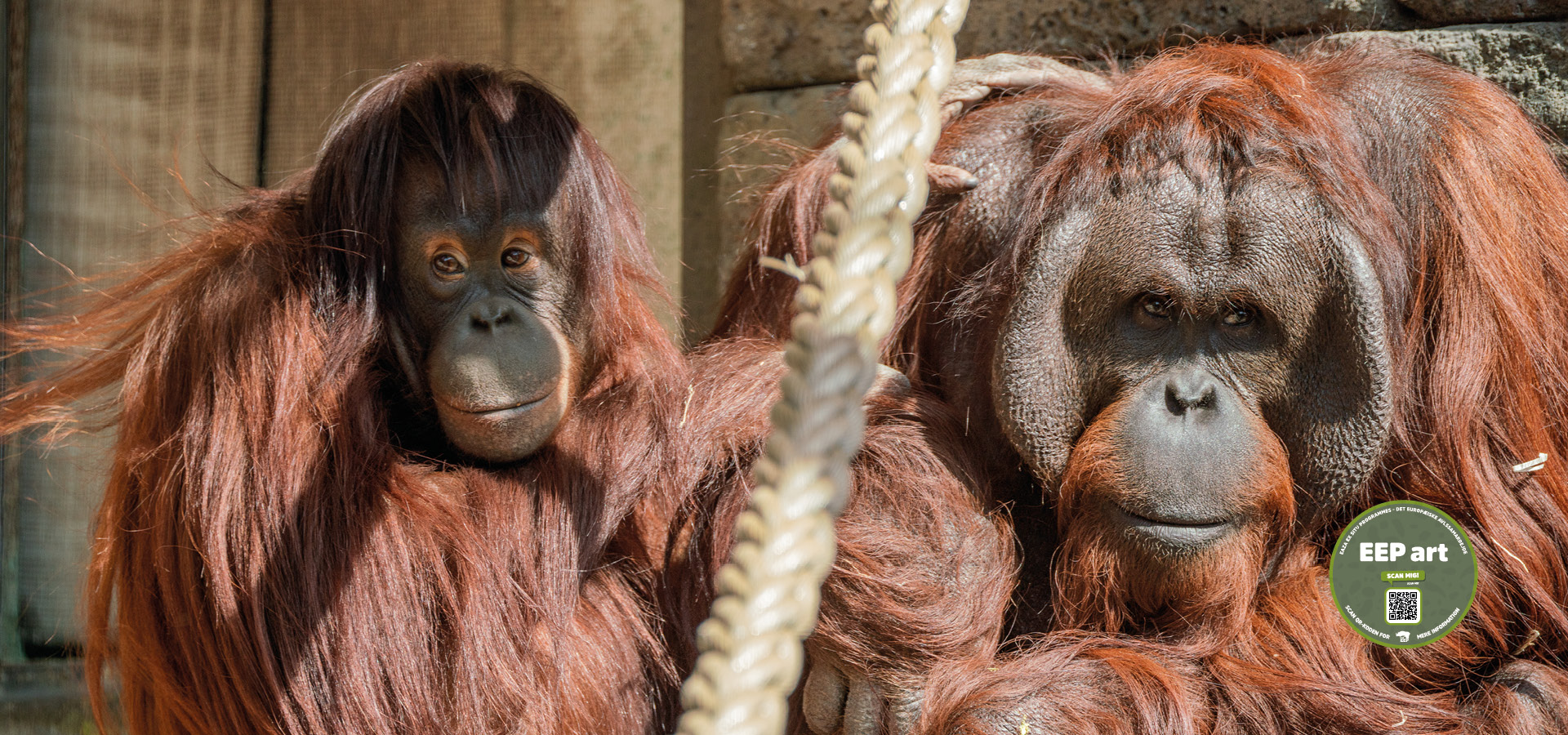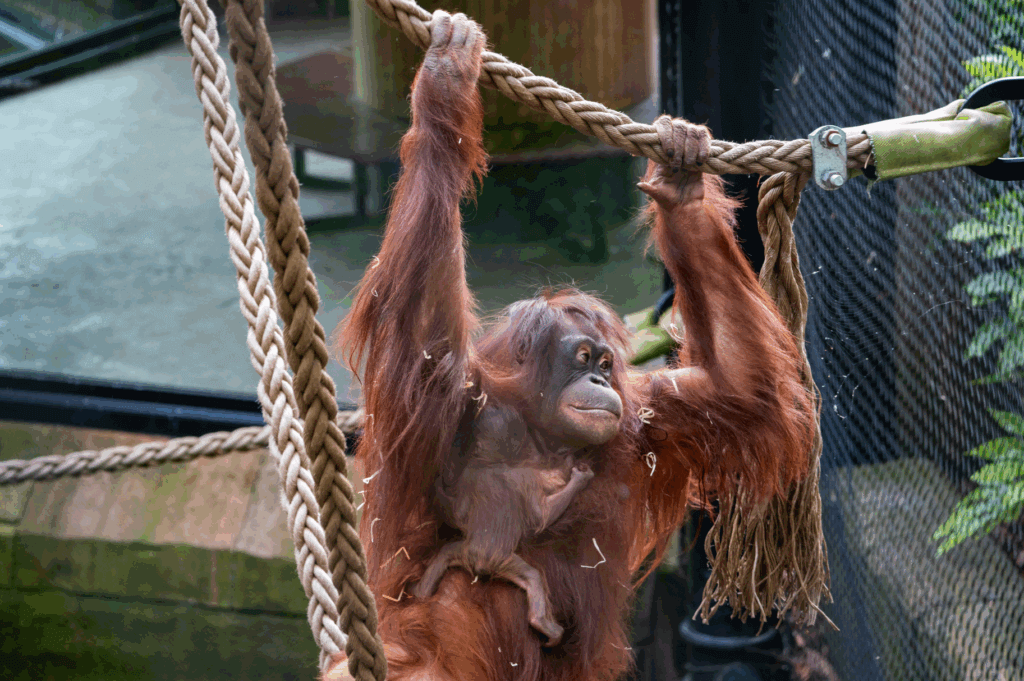
Bornean orangutan
Orangutan means forest man in Malaysian. Orang means forest and utan means human. The correct spelling is therefore "orangutan", which is also the official spelling in all countries other than Denmark.
The orangutan is the only true tree-dwelling great ape. So although it is smaller than the gorilla, it is stronger in the arms as it is more of a climber.
The orangutan's arms can have a reach of up to 250 centimetres.
Orangutans typically give birth to one calf and the female lives with her calf for the first 6-7 years of life. The babies are breastfed for 2-3 years, but during the first year they are also fed chewed fruit and vegetables.
Adult males live alone. They develop a prominent cheek pouch of fat and connective tissue that attracts females as soon as they are sexually mature and dominant.
Males develop a large laryngeal sac that acts as an amplifier when the orangutans roar.
There are three species of orangutan, one found in Borneo and the other two in Sumatra.
It is estimated that between 50,000 and 100,000 orangutans live in the wild in Borneo today, and the population is rapidly declining.
- Distribution: Lives in the rainforests of Borneo
- Population: Critically endangered, mainly due to deforestation but also due to hunting and trapping
- Weight: Male: 60-90kg. Female: 40-50 kilos
- Height: Male: 140 centimetres. Female: 115 centimetres
- Mating season: All year round
- Sexual maturity: From 8-10 years of age
- Gestation: 260-270 days
- Number of cubs: Usually 1
- Food: Plants: tropical fruits, leaves, shoots, bark. Also insects and eggs. Able to eat unripe fruit, giving them an advantage over other frugivores
- Zoo menu: Fruit and vegetables, fresh branches and monkey pills
- Lifespan: Up to 35 years in the wild. In zoos, the oldest recorded orangutan is 56 years old
- Latin name: Pongo pygmaeus
Read on and get to know the orangutan even better
In principle, an orangutan is far too big and heavy to master tree climbing, but still manages to elegantly navigate its way through the treetops. If an orangutan jumped between the branches, they would simply snap. Instead, the orangutan uses its long arms to stretch from branch to branch and swing forwards. With its huge and strong hands, the orangutan is able to grab onto branches and support its own weight effortlessly. In fact, an orangutan is about ten times stronger in its hands and arms than an adult man.
The orangutan is not only known for its impressive strength, but also for its excellent fine motor skills in the hands, making them extremely adept at using tools to find food. This is evident in their behaviour, such as sticking branches into termite nests to fish out termites or sticking branches into beehives to get honey. At Aalborg Zoo, the keepers spend a lot of time stimulating this behaviour through various activities. In addition, they train the orangutans to allow the keepers to get close to them. This allows the keepers to carry out health checks such as fur tests or dental checks without having to anaesthetise them.
Aalborg Zoo's orangutans
Aalborg Zoo is the only place in Denmark where you can experience orangutans. Aalborg Zoo's orangutans are Bornean orangutans.
In June 2022, male Pal and female Ruti were the first to move into our brand new orangutan enclosure. The large new outdoor enclosure is designed to accommodate the animals' natural behaviour. The facility includes climbing ropes, cosy nesting areas and sway poles that allow the orangutans to move as they do in the wild, and the over 10-metre high enclosure gives the animals optimal opportunities to get up high and get a view and overview.
The intention is for Ruti and Pal to form a new breeding pair together, contributing to their critically endangered species.

Orangutan birth at Aalborg Zoo
On Wednesday morning, animal keepers arrived at Aalborg Zoo's orangutan enclosure to a touching sight: Ruti the orangutan had given birth to a baby orangutan, still wet and new in the grass with the placenta next to her. A new life - and the beginning of some of the most nerve-wracking and touching days at the zoo.
Caring without experience
Although Ruti showed care and curiosity towards her baby from the start, she didn't quite know what to do with it. She tried to comfort it with her tongue and fingers, but she couldn't put it to her breast and the little one cried.
"At first we were relieved to see that the baby was alive. But we quickly became worried. Ruti seemed loving and attentive, but she didn't understand what the baby needed. It was heartbreaking to watch. We couldn't help her directly, but we had to hope that she would figure it out herself. I haven't had those feelings in my body since the births of my own children," says Kenneth Madsen, keeper in charge of primates at Aalborg Zoo.
In the wild, young female orangutans often learn motherhood by observing their own mothers. But Ruti, who arrived at Aalborg Zoo in 2022, has had no role models to look up to. She is part of an international breeding programme where she was matched with the male Pal, who arrived at Aalborg Zoo a few days after Ruti. Despite good conditions, it is far from a given that orangutans in zoos will mate - let alone have babies.
"That's why this is so great. It says everything about their well-being that we see natural mating - and that they have managed to create a chick together. It's a great victory for both the animals and the long-term work with the species," explains Kenneth Madsen.
A joint effort from staff and guests
After a few days of turmoil, despair and hope, the keepers decided to take unconventional measures. With no outerwear and orangutan teddy bears from the shop, Trine, who is also a keeper with the primates, simulated breastfeeding in front of Ruti, where a female guest with a newborn baby also offered to breastfeed in front of Ruti. All in the hope that Ruti would realise how she could help the baby, who was becoming more limp.
And suddenly it happened.
"It was a moment we'll never forget. She put the baby down and it started to suckle. You could almost feel the relief spread throughout the garden," says Kenneth Madsen.
Since then, the cub has been eating, sleeping and snuggling up to its mum. Ruti is lovingly caring for the little one and the two seem to be thriving in the facility. Visitors can already catch a glimpse of them as they bond and slowly find their rhythm together.
And the whole of Aalborg Zoo is filled with relief and joy. The staff are breathing again and enjoying the motherhood that is now unfolding in the centre of the garden.